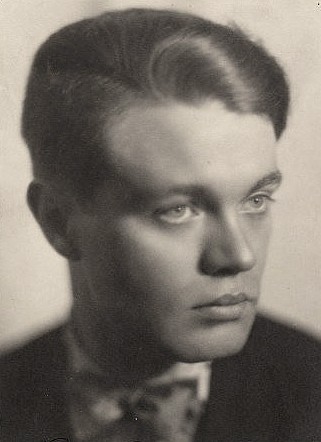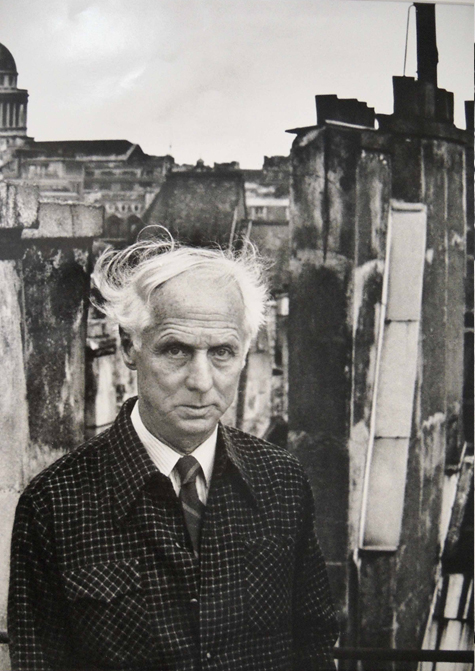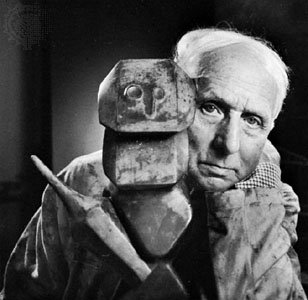<Back to Index>
- Writer René Crevel, 1900
- Painter and Sculptor Max Ernst, 1891
PAGE SPONSOR

René Crevel (10 August 1900 – 18 June 1935) was a French writer involved with the surrealist movement.
Crevel was born in Paris to a family of Parisian bourgeoisie. He had a traumatic religious upbringing. At the age of fourteen, during a difficult stage of his life, his father committed suicide by hanging himself. Crevel studied English at the University of Paris. He met André Breton and joined the surrealist movement in 1921, from which he would be excluded in October 1923 due to Crevel's homosexuality and Breton's belief that the movement had been corrupted.
During this period, Crevel wrote novels such as Mon corps et moi ("My Body and Me"). In 1926, he was diagnosed with tuberculosis which made him start using morphine. The 1929 exile of Léon Trotsky persuaded him to rejoin the surrealists. Remaining faithful to André Breton, he struggled to bring communists and surrealists closer together. Much of Crevel's work deals with his inner turmoil at being bisexual.
Crevel killed himself by turning on the gas on his kitchen stove the night of 18 June 1935, several weeks before his 35th birthday. There were at least two direct reasons: (1) There was a conflict between Breton and Ilya Ehrenburg during the first "International Congress of Writers for the Defense of Culture" which opened in Paris in June 1935. Breton, who like all fellow surrealists, had been insulted by Ehrenburg in a pamphlet which said – among other things – that surrealists were pederasts, slapped Ehrenburg several times on the street, which led to surrealists being expelled from the Congress. Crevel, who according to Salvador Dalí, was "the only serious communist among surrealists" (and was facing more and more solitude as the real face of Soviet socialism started to occur), spent a whole day trying to persuade the other delegates to allow surrealists back, but he was not successful and left the Congress at 11pm, totally exhausted. (2) Crevel reportedly had learned that he suffered from renal tuberculosis right upon leaving the Congress (Claude Courtot). He left a note which read "Please cremate my body. Loathing."
It should be remembered that when André Breton included the question "Suicide: Is It a Solution?" in the first issue of La Révolution surréaliste in 1925, Crevel was one of those who answered "Yes". He wrote "It is most probably the most correct and most ultimate solution."


Max Ernst (2 April 1891 – 1 April 1976) was a German painter, sculptor, graphic artist and poet. A prolific artist, Ernst was one of the primary pioneers of the Dada movement and Surrealism.
Ernst was born on April 2, 1891, in Brühl, near Cologne, the third of nine children of a middle class Catholic family. His father Philipp Ernst was a teacher of the deaf and an amateur painter. A devout Christian and a strict disciplinarian, he inspired in his son a penchant for defying authority, while his interest in painting and sketching in nature influenced Max Ernst to take up painting himself. In 1909 Ernst enrolled in the University of Bonn, studying philosophy, art history, literature, psychology and psychiatry. He visited asylums and became fascinated with the art of the mentally ill patients; he also started painting this year, producing sketches in the garden of the Brühl castle and portraits of his sister and himself. In 1911 Ernst befriended August Macke and joined his Die Rheinischen Expressionisten group of artists, deciding to become an artist. In 1912 he visited the Sonderbund exhibition in Cologne, where works by Pablo Picasso and post - Impressionists such as Vincent Van Gogh and Paul Gauguin profoundly influenced his approach to art. His own work was exhibited the same year together with that of the Das Junge Rheinland group, at Galerie Feldman in Cologne, and then in several group exhibitions in 1913.
In 1914 Ernst met Hans Arp
in Cologne. The two soon became friends and their relationship lasted
for fifty years. After Ernst completed his studies in the summer, his
life was interrupted by World War I.
Ernst was drafted and served both on the Western and the Eastern front.
Such was the devastating effect of the war on the artist that in his
autobiography he referred to his time in the army thus: "On the first of
August 1914 M[ax].E[rnst]. died. He was resurrected on the eleventh of
November 1918." However, for a brief period on the Western front, Ernst's position was charting maps, which allowed him to continue painting. Several German Expressionist painters died in action during the war, among them Macke and Franz Marc.
Ernst was demobilized in 1918 and returned to Cologne. He soon married art history student Luise Straus, whom he met in 1914. Next year Ernst visited Paul Klee in Munich and studied paintings by Giorgio de Chirico, which left a deep impression on him. The same year, inspired partly by de Chirico and partly by studying mail order catalogs, teaching aide manuals, and similar sources, he produced his first collages (notably Fiat modes, a portfolio of lithographs), a technique which would come to dominate his artistic pursuits in the years to come. Also in 1919 Ernst, social activist Johannes Theodor Baargeld, and a number of their friends and colleagues founded the Cologne Dada group. In 1919 – 20 Ernst and Baargeld published various short lived magazines such as Der Strom and die schammade and organized Dada exhibitions.
Ernst's son Ulrich 'Jimmy' Ernst was born on 24 June 1920. He went on to become a painter like his father, but Ernst's marriage to Luise was short lived. In 1921 he met Paul Éluard, who became a close lifelong friend. Éluard bought two of Ernst's paintings (Celebes and Oedipus Rex) and selected six collages to illustrate his poetry collection Répétitions. A year later the two collaborated on Les malheurs des immortels, and then, with André Breton whom Ernst met in 1921, on the magazine Litterature. In 1922, unable to secure the necessary papers, Ernst entered France illegally and settled into a ménage à trois with the Éluards in Paris suburb Saint - Brice, leaving behind his wife and son.
During his first two years in Paris Ernst took various odd jobs to make
a living and continued to paint. In 1923 the Éluards moved to a new
home in Eaubonne, near Paris, where Ernst painted numerous murals. The same year his works were exhibited at Salon des Indépendants.
Although apparently accepting the ménage à trois at first, Éluard eventually became more concerned about the affair. In 1924 he abruptly left, first for Monaco, and then for Saigon, Vietnam. He soon asked his wife and Max Ernst to join him; both had to sell numerous paintings to finance the trip. Ernst went to Düsseldorf and sold a large number of his works to a longtime friend, Johanna Ey, owner of gallery Das Junge Rheinland. After a brief time together in Saigon, the trio decided that Gala would remain with Paul. The Éluards returned to Eaubonne in early September, while Ernst followed them some months later, after exploring more of South - East Asia. He returned to Paris in late 1924 and soon signed a contract with Jacques Viot that allowed him to paint full time. In 1925 Ernst established a studio at 22, rue Tourlaque.
Constantly experimenting, in 1925 he invented a graphic art technique called frottage (a Surrealist technique), which uses pencil rubbings of objects as a source of images. He also created another technique called 'grattage' in which paint is scraped across canvas to reveal the imprints of the objects placed beneath. He uses this technique in his famous painting Forest and Dove (as shown at the Tate Modern).
The next year he collaborated with Joan Miró on designs for Sergei Diaghilev. With Miró's help, Ernst pioneered grattage in which he troweled pigment from his canvases. He also explored with the technique of decalcomania which involves pressing paint between two surfaces.
Ernst developed a fascination with birds that was prevalent in his work. His alter ego in paintings, which he called Loplop,
was a bird. He suggested that this alter ego was an extension of
himself stemming from an early confusion of birds and humans. He said
that one night when he was young he woke up and found that his beloved
bird had died, and a few minutes later his father announced that his
sister was born. Loplop often appeared in collages of other artists'
work, such as Loplop presents André Breton. Ernst drew a great deal of controversy with his 1926 painting The Virgin Chastises the infant Jesus before Three Witnesses: André Breton, Paul Éluard, and the Painter.
In 1927 he married Marie - Berthe Aurenche, and it is thought his
relationship with her may have inspired the erotic subject matter of The Kiss and other works of this year. In 1930, he appeared in the film L'Âge d'Or, directed by self identifying Surrealist Luis Buñuel. Ernst began to make sculpture in 1934, and spent time with Alberto Giacometti. In 1938, the American heiress and artistic patron Peggy Guggenheim
acquired a number of Max Ernst's works which she displayed in her new
museum in London. Ernst and Peggy Guggenheim were also married to one
another from 1942 to 1946.
In September 1939, the outbreak of World War Two caused Ernst to be interned as an "undesirable foreigner" in Camp des Milles, near Aix - en - Provence, along with fellow surrealist, Hans Bellmer, who had recently emigrated to Paris. Thanks to the intercession of Paul Éluard and other friends, including the journalist Varian Fry, he was discharged a few weeks later. Soon after the Nazi occupation of France, he was arrested again, this time by the Gestapo, but managed to escape and flee to America with the help of Guggenheim. He left behind his lover, Leonora Carrington, and she suffered a major mental breakdown. Ernst and Guggenheim arrived in the United States in 1941 and were married the following year. Along with other artists and friends (Marcel Duchamp and Marc Chagall) who had fled from the war and lived in New York City, Ernst helped inspire the development of Abstract expressionism.
His marriage to Guggenheim did not last, and in Beverly Hills, California, in October 1946, in a double ceremony with Man Ray and Juliet P. Browner, he married Dorothea Tanning. The couple first made their home in Sedona, Arizona. In 1948 Ernst wrote the treatise Beyond Painting. As a result of the publicity, he began to achieve financial success.
In 1953 he and Tanning moved to a small town in the south of France where he continued to work. The City, and the Galeries Nationales du Grand - Palais in Paris published a complete catalog of his works. In 1966 he created a chess set made of glass which he named "Immortel"; it has been described by the poet André Verdet as "a masterpiece of bewitching magic, worthy of a Maya palace or the residence of a Pharaon".
Ernst died on 1 April 1976 in Paris. He was interred at the Père Lachaise Cemetery.
Max Ernst's life and career are the subject of Peter Schamoni's 1991 documentary Max Ernst. Dedicated to the art historian Werner Spies, it was assembled from interviews with Ernst, stills of his paintings and sculptures, and the memoirs of his wife Dorothea Tanning and son Jimmy. The 101 minute German film was released on DVD with English subtitles by Image Entertainment.
In 2005, "Max Ernst: A Retrospective" opened at the Metropolitan Museum of Art and included works such as Celebes (1921), Ubu Imperator (1923) and Fireside Angel (1937), which is one of the few definitively political pieces and is sub-titled The Triumph of Surrealism depicting a raging bird - like creature that symbolizes the wave of fascism that took over Europe. The exhibition also includes Ernst's works that experiment with free association writing and the techniques of frottage, created from a rubbing from a textured surface; grattage, involving scratching at the surface of a painting; and decalcomania, which involves altering a wet painting by pressing a second surface against it and taking it away.
Ernst's son Jimmy, a well known German / American abstract expressionist painter, who lived on the south shore of Long Island, died in 1984. His memoirs, A Not - So - Still Life, were published shortly before his death. His grandson Eric and granddaughter Amy are both artists and writers.